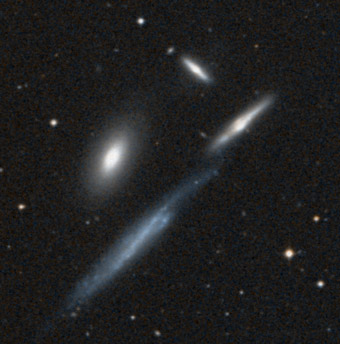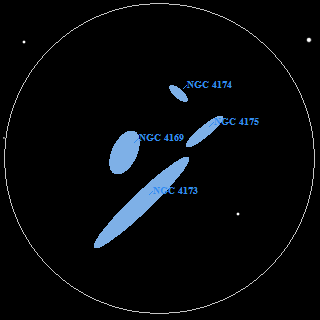| Galaxy
Group
RA: 12h12m23.9s Dec: +29°10'40" (Coma Berenices) Integrated Visual Magnitude: 13-14 Angular Diameter: 3.8' Member galaxies: 4 Light Time: 200 Myr Minimum requirements to detect: 12-inch under dark skies |
 Hickson
61, sometimes called "The Box", is a very tight grouping of four
galaxies that form a nearly perfect rectangle. Contained within a
field of just 3.8', they all will fit into the same medium-power field.
Particularly striking in the eyepiece is how the two highly elongated galaxies
line up, nearly forming one long streak.
Hickson
61, sometimes called "The Box", is a very tight grouping of four
galaxies that form a nearly perfect rectangle. Contained within a
field of just 3.8', they all will fit into the same medium-power field.
Particularly striking in the eyepiece is how the two highly elongated galaxies
line up, nearly forming one long streak.
The brightest member, the 13.3-magnitude Lenticular galaxy NGC 4169, can probably be glimpsed in an 8-inch. In my 18-inch at 260x it appeared features and round.
The next easiest to detect is the tiny NGC 4174, a nearly edge-on 14.5 magnitude spiral. At 94x it appeared nearly stellar and could be easily mistaken for a star. At 260x the bright central core appeared nearly stellar, but a slight, elongated haze could also be detected.
NGC 4175 is 14.3-magnitude edge-on spiral that shows evidence of interaction with a neighbor. At 260x this galaxy appeared as an elongated haze.
Finally, NGC 4173 is the largest of the four, but the most difficult. Another interacting spiral galaxy, this 13.8 magnitude galaxy has a very low mean surface brightness of 23.7 mag/arc-sec2. This one can be difficult and was not at all obvious at 94x. It was more easily seen ay 260x, where it appeared long, thin, and quite diffuse. It is this galaxy and the nearby NGC 4175 that together form a nearly perfect line. Interestingly, the three other galaxies all have recession velocities of around 2900 km/sec, but at 1100 km/sec NGC 4173 is receding much more slowly. C. Mendes de Oliveira applied the Tully-Fisher relation to these galaxies as an independent method of determining their distances. The Tully-Fisher relation applies the empircal relationship between the Luminosity of a spiral galaxy and its rotational velocity. Once the rotational velocity is measured, the Luminosity can be inferred and this together with the apparent brightness of the galaxy gives us an estimate of its distance. It truns out that, as the recessional velocities indicate, NGC 4173 is a foreground object not physically associated despite the coincidental evidence of interaction.

The field in an 12-inch at 300x. North is down and east is to the right.
| Millennium
Star Atlas Vol II Chart 655
Sky Atlas 2000 Chart 7 Uranometria 2000 Vol I Chart 107 Herald-Bobroff Astroatlas B-05 C-21 |